Expert Review
Nissan Juke Hatchback (2014 - ) review
The Nissan Juke is a sales phenomenon, and the 2014 version adds a bigger boot, better on-board tech and new personalisation options to help it take on the Kia Soul, Renault Captur and Mini Countryman
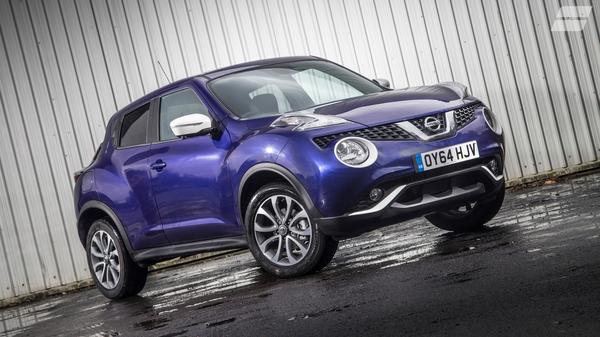

Words by: Ivan Aistrop
Published on 18 March 2015 | 0 min read
The Auto Trader expert verdict:
3.1
The original mini-SUV is distinctively styled, good value for money and well equipped. The chassis, build quality and refinement, however, are all below the standards of what you'll find in the best cars in this class.
Reasons to buy:
- Distintive styling
- Nippy 1.2 petrol engine
- Plenty of gadgets
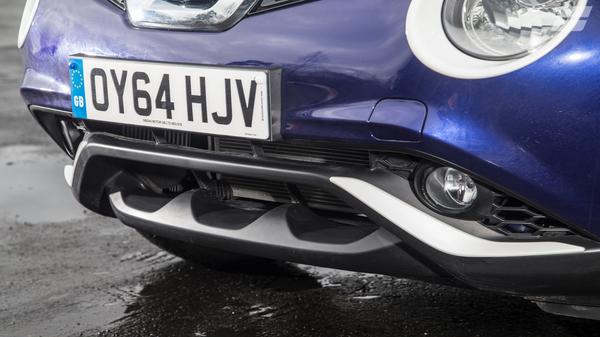
How good does it look?
“There are also plenty of options for personalising the car, with contrasting trims and colours for the bumpers, headlights and even the wheels”
There’s no mistaking the Nissan Juke – it still looks unlike anything else on the road, with its huge headlights and sidelight pods mounted high on the bonnet. The rear is more conventional, although the Juke's rear lights are another standout feature and the sides are full of curves, something that’s not often clear in pictures. There are also plenty of options for personalising the car to suit your own tastes, with contrasting trims and colours for the bumpers, headlights, and the wheels, which you can swap, mix and match. Even entry-level cars have alloy wheels, and they range from 16- to 18-inches across as you get higher up the range. The sportiest RS versions also feature a Nismo bodykit, red door mirrors, 18-inch alloy wheels and red brake calipers.
Expert rating: 4/5
What's the interior like?
The Juke’s interior isn’t as striking as the bodywork, with the colour-coded centre console the high point in an otherwise sober cabin. The plastics used for the dashboard and door panels are hard to the touch, and lack the tactility of more upmarket rivals. Choose the Acenta Premium trim and above and you'll get a smart touch-screen display, and gloss black finishes on most of the cabin surfaces, but cars that come in below this trim level feel a bit Spartan inside. You sit as high in the Juke as in many SUVs, but thanks to its supermini width and length, it’s still town-friendly. However, finding the right driving position is not that easy, thanks to a lack of adjustability for the steering wheel, and rather firm, unsupportive seats.
Expert rating: 3/5
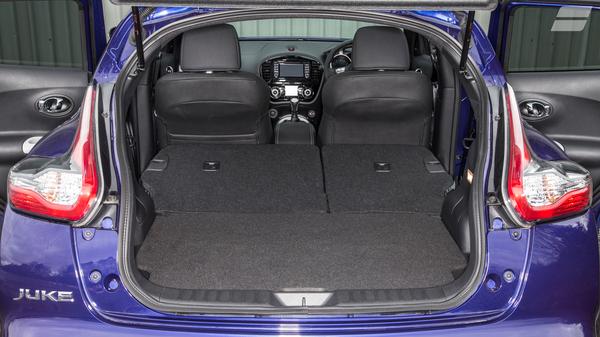
How practical is it?
“The boot is reasonable on front-wheel drive versions, measuring 354 litres, which is more than a Ford Focus”
The Juke works best with two adult passengers up front and a couple of children or luggage in the back. There’s plenty of space in the front, although it feels as if the large centre console robs kneeroom. Rear space suffers on two fronts, with the car’s sloping, coupe-like roofline reducing headroom, while the narrow side windows and dark headlining of the roof make the rear seats feel claustrophobic for even modestly sized adults. The boot is reasonable on front-wheel drive versions, measuring 354 litres, which is more than a Ford Focus, and there is a raised false floor that sits level with the otherwise awkward boot lip, and gives you a handy place to store valuable or loose items underneath. Be warned, though, that four-wheel drive models have to make do with just 207 litres boot capacity, while the Skoda Yeti offers nearly twice that, and the Renault Captur has considerably more room. The Juke is genuinely compact, though, and has a tight turning circle, so unlike some of its larger rivals the Nissan has is really easy to manoeuvre in town.
Expert rating: 3/5
What's it like to drive?
This isn’t where the Juke shines. The ride is bouncy and unsettled on most surfaces, particularly in the Nismo RS model, and potholes will result in a fair old whack in the backside. Despite the suspension’s firmness, the raised ride height also means there’s a fair bit of body lean in tight bends, so it's best to drive the Juke at a steady pace (yes, even the Nismo). There’s also not a lot of grip – the nose will wash wide in corners if you take them with too much enthusiasm. This is especially problematic in wet weather, but this lack of stability, combined with the inconsistent and vague steering, means the Juke isn't as rewarding to drive as its rivals. The fastest turbocharged petrol models are especially susceptible to this unwelcome trait, and you’ll also find that the front wheels spin up too easily when you accelerate. Sadly, all these traits are also present in the Nismo RS models, so you end up having to drive them within their limitations. Suffice to say that, if you're after hot hatch-style thrills from them, you'll come away mighty frustrated.
Expert rating: 2/5
How powerful is it?
Five engines are available in the Juke: three 1.6-litre petrols, a 1.2-litre turbo petrol and a 1.5-litre diesel. The entry-level model is the 1.6-litre non-turbo, which develops 93bhp and is cheap, but only available in the lowest trims. Its performance is best described as asthmatic, but the 113bhp 1.2-litre turbo is much better, with decent acceleration in-gear, and a six-speed gearbox that improves refinement at motorway speeds. Around town, though, it does have a noticeable turbo whistle that can get annoying. The 1.6-litre turbo is fairly rapid, and the extra power provided (187bhp) cuts the 0-62mph time to 7.8 seconds, while the Nismo RS has a 215bhp version of the same engine for proper hot hatch pace - although it's delivered in an old school hot hatch way, with all the power at the top end of the rev range, demanding an exhausting number of gearchanges to produce that pace. The diesel unit isn’t as refined as the best in class, but with 110bhp it matches the lowest-powered petrol engine for performance - if not in-gear flexibility or smoothness.
Expert rating: 3/5
How much will it cost me?
The cheaper versions of the Juke are excellent value for money, particularly given the standard equipment the car gets, but the faster models look expensive. The diesel offers the lowest daily running costs – 104g/km of CO2 and an average of 70.6mpg – but the engine is significantly more expensive than petrol versions, so the car needs to cover a lot of miles before the price premium is recouped. The non-turbo 1.6 emits 138g/km and averages 47.1mpg, but the turbocharged 1.2 will be cheaper to tax despite its increased performance, with a CO2 figure of 129g/km and a combined economy nudging 50mpg. The CVT automatic and four-wheel-drive models increase the running costs further still. All these figures are reasonable for the class, but some key rivals are more efficient. Still, the Juke’s solid residuals mean it should retain a sizeable chunk of its original price.
Expert rating: 3/5
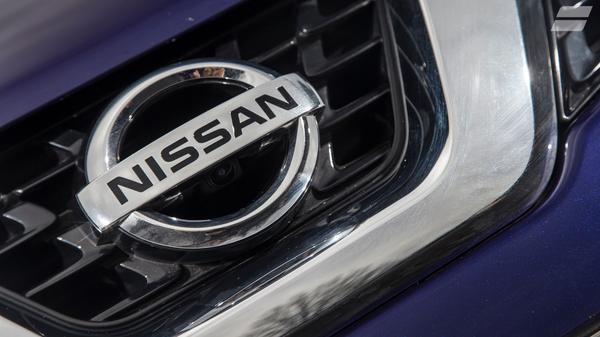
How reliable is it?
“Nissan has a good reputation for building tough cars, and most owners appear to be very happy with their purchase”
Despite some of the interior trim pieces feeling a little fragile – the centre console can be moved from side-to-side – the Juke seems like a solidly built car. The low-power 1.6 and 1.5 diesel engines have been offered in a wide range of other models including the larger Qashqai SUV, and have proved to be fairly dependable. Nissan has a good reputation for building tough cars, and most owners appear to be happy with their purchase - although many do say that the small fuel tank and below-average mpg were niggling issues.
Expert rating: 3/5
How safe is it?
The Nissan Juke has achieved the maximum five-star rating in Euro NCAP crash tests. Standard safety kit includes six airbags, ISOFIX child seat anchors, whiplash-reducing front headrests, anti-lock brakes with electronic brakeforce distribution, brake assist and electronic stability programme. This latest Juke also benefits from a host of Safety Shield' features - standard on the highest trims and optional on the rest - which include active kit like blind-spot assist, land departure warning and a 360 degree parking camera.
Expert rating: 4/5
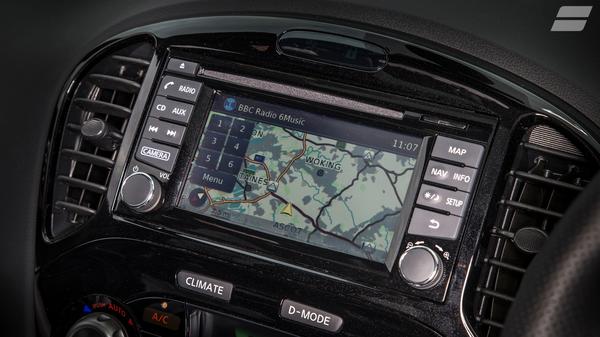
How much equipment do I get?
“Our pick of the range, the Acenta Premium, includes a handy touch-screen display, which comes with sat-nav, a reversing camera and DAB digital radio built in”
Five equipment grades are available in the Juke range: Visia, Acenta, Acenta Premium, Tekna and Nismo. Unlike some rivals, all models feature remote central locking, front and rear electric windows, electric mirrors, alloy wheels and air-con. The Acenta model adds Nissan's Dynamic Control System, which adjusts the steering and accelerator pedal feel, and Bluetooth. Our pick of the range, the Acenta Premium, includes the superb Nissan Connect touch-screen, which comes with navigation, a reversing camera and DAB radio built in. Tekna models add leather upholstery, heated seats and auto lights and wipers, while the Nismos get beefy-looking bumpers, skirts and spoilers. These last two versions are pretty expensive, though, and not worth the extra outlay.
Expert rating: 3/5
Why buy?
The Juke is bought by lovers of its funky looks, but beneath an unusual face sits a well-priced and well-equipped car that is small enough to work in town, and gives its drivers a better view out than the average supermini. Stick with the cheaper petrol and diesel models, and you’ll have an urban runabout that’s stylish and fairly cheap to run. However, motorway refinement, build quality and practicality are all behind the best new crossovers.
Expert rating: 3/5